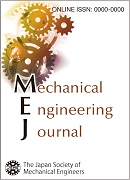Volume 4, Issue 3
Displaying 1-19 of 19 articles from this issue
- |<
- <
- 1
- >
- >|
Energy Solutions for a Sustainable Future
-
2017 Volume 4 Issue 3 Pages 16-00495
Published: 2017
Released on J-STAGE: June 15, 2017
Advance online publication: December 26, 2016Download PDF (2254K) -
2017 Volume 4 Issue 3 Pages 16-00592
Published: 2017
Released on J-STAGE: June 15, 2017
Advance online publication: February 28, 2017Download PDF (1399K) -
2017 Volume 4 Issue 3 Pages 16-00597
Published: 2017
Released on J-STAGE: June 15, 2017
Advance online publication: March 17, 2017Download PDF (2071K) -
2017 Volume 4 Issue 3 Pages 16-00577
Published: 2017
Released on J-STAGE: June 15, 2017
Advance online publication: June 13, 2017Download PDF (2753K) -
2017 Volume 4 Issue 3 Pages 16-00567
Published: 2017
Released on J-STAGE: June 15, 2017
Advance online publication: February 27, 2017Download PDF (15861K) -
2017 Volume 4 Issue 3 Pages 16-00517
Published: 2017
Released on J-STAGE: June 15, 2017
Advance online publication: February 27, 2017Download PDF (2778K) -
2017 Volume 4 Issue 3 Pages 16-00558
Published: 2017
Released on J-STAGE: June 15, 2017
Advance online publication: March 23, 2017Download PDF (1853K) -
2017 Volume 4 Issue 3 Pages 16-00587
Published: 2017
Released on J-STAGE: June 15, 2017
Advance online publication: June 09, 2017Download PDF (2123K)
Fluids Engineering
-
2017 Volume 4 Issue 3 Pages 16-00699
Published: 2017
Released on J-STAGE: June 15, 2017
Advance online publication: April 26, 2017Download PDF (2529K)
Thermal, Engine and Power Engineering
-
2017 Volume 4 Issue 3 Pages 17-00096
Published: 2017
Released on J-STAGE: June 15, 2017
Advance online publication: June 07, 2017Download PDF (3809K) -
2017 Volume 4 Issue 3 Pages 16-00520
Published: 2017
Released on J-STAGE: June 15, 2017
Advance online publication: June 08, 2017Download PDF (6718K)
Dynamics & Control, Robotics & Mechatronics
-
2017 Volume 4 Issue 3 Pages 16-00722
Published: 2017
Released on J-STAGE: June 15, 2017
Advance online publication: May 09, 2017Download PDF (5287K) -
2017 Volume 4 Issue 3 Pages 16-00427
Published: 2017
Released on J-STAGE: June 15, 2017
Advance online publication: May 17, 2017Download PDF (8111K) -
2017 Volume 4 Issue 3 Pages 17-00152
Published: 2017
Released on J-STAGE: June 15, 2017
Advance online publication: May 19, 2017Download PDF (3752K)
Computational Mechanics
-
2017 Volume 4 Issue 3 Pages 17-00120
Published: 2017
Released on J-STAGE: June 15, 2017
Advance online publication: April 21, 2017Download PDF (4866K)
Design, Manufacturing, Information and Systems
-
2017 Volume 4 Issue 3 Pages 16-00406
Published: 2017
Released on J-STAGE: June 15, 2017
Advance online publication: May 17, 2017Download PDF (1313K)
Bio, Medical, Sports and Human Engineering
-
2017 Volume 4 Issue 3 Pages 16-00476
Published: 2017
Released on J-STAGE: June 15, 2017
Advance online publication: April 20, 2017Download PDF (4196K) -
2017 Volume 4 Issue 3 Pages 16-00279
Published: 2017
Released on J-STAGE: June 15, 2017
Advance online publication: May 09, 2017Download PDF (4085K)
Transportation and Logistics
-
Aerodynamic force and moment measurement for crosswind stability assessment in a compact wind tunnel2017 Volume 4 Issue 3 Pages 17-00034
Published: 2017
Released on J-STAGE: June 15, 2017
Advance online publication: May 10, 2017Download PDF (1752K)
- |<
- <
- 1
- >
- >|
